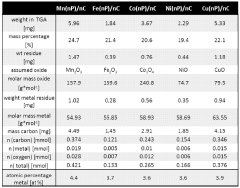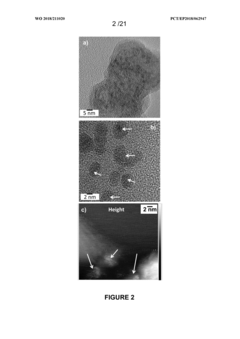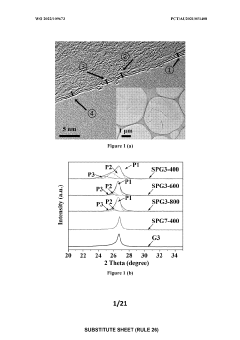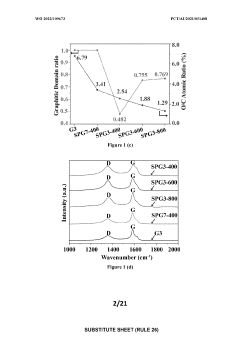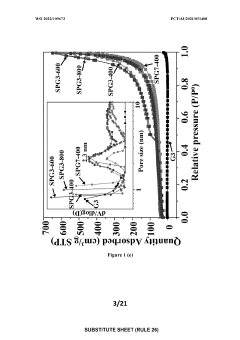Exploring Graphene Battery Applications in Renewable Sectors
AUG 6, 20259 MIN READ
Generate Your Research Report Instantly with AI Agent
Patsnap Eureka helps you evaluate technical feasibility & market potential.
Graphene Battery Evolution and Objectives
Graphene batteries have emerged as a promising technology in the field of energy storage, particularly for renewable energy applications. The evolution of graphene batteries can be traced back to the discovery of graphene in 2004, which sparked intense research into its potential applications across various industries. In the context of energy storage, graphene's exceptional properties, including high electrical conductivity, mechanical strength, and large surface area, have made it an attractive material for battery development.
The initial stages of graphene battery research focused on understanding the material's fundamental properties and exploring its potential as an electrode material. Scientists and engineers worked on developing methods to synthesize high-quality graphene and integrate it into existing battery architectures. As research progressed, the focus shifted towards optimizing graphene-based electrodes and electrolytes to enhance battery performance, including increased energy density, faster charging rates, and improved cycle life.
In recent years, the objectives of graphene battery development have become more aligned with the needs of the renewable energy sector. One primary goal is to create high-capacity energy storage systems that can effectively store and distribute power generated from intermittent renewable sources such as solar and wind. This includes developing large-scale stationary batteries for grid-level energy storage, as well as more compact and efficient batteries for electric vehicles and portable electronics.
Another key objective is to improve the sustainability and environmental impact of battery production and disposal. Graphene batteries have the potential to reduce the reliance on rare and toxic materials commonly used in conventional lithium-ion batteries. Researchers are working on developing graphene-based batteries that are more environmentally friendly, both in terms of raw material sourcing and end-of-life recycling.
The current technological landscape aims to overcome several challenges in graphene battery development. These include scaling up production processes to achieve commercial viability, enhancing the stability and safety of graphene-based battery systems, and optimizing the integration of graphene with other battery components. Researchers are also exploring hybrid systems that combine graphene with other advanced materials to create synergistic effects and further improve battery performance.
Looking ahead, the evolution of graphene batteries is expected to continue with a focus on pushing the boundaries of energy density, charging speed, and cycle life. There is also a growing emphasis on developing flexible and lightweight battery designs to enable new applications in wearable technology and IoT devices. As the renewable energy sector expands, the objectives for graphene battery technology will likely include further improvements in large-scale energy storage solutions and the development of smart battery systems capable of integrating with advanced grid management technologies.
The initial stages of graphene battery research focused on understanding the material's fundamental properties and exploring its potential as an electrode material. Scientists and engineers worked on developing methods to synthesize high-quality graphene and integrate it into existing battery architectures. As research progressed, the focus shifted towards optimizing graphene-based electrodes and electrolytes to enhance battery performance, including increased energy density, faster charging rates, and improved cycle life.
In recent years, the objectives of graphene battery development have become more aligned with the needs of the renewable energy sector. One primary goal is to create high-capacity energy storage systems that can effectively store and distribute power generated from intermittent renewable sources such as solar and wind. This includes developing large-scale stationary batteries for grid-level energy storage, as well as more compact and efficient batteries for electric vehicles and portable electronics.
Another key objective is to improve the sustainability and environmental impact of battery production and disposal. Graphene batteries have the potential to reduce the reliance on rare and toxic materials commonly used in conventional lithium-ion batteries. Researchers are working on developing graphene-based batteries that are more environmentally friendly, both in terms of raw material sourcing and end-of-life recycling.
The current technological landscape aims to overcome several challenges in graphene battery development. These include scaling up production processes to achieve commercial viability, enhancing the stability and safety of graphene-based battery systems, and optimizing the integration of graphene with other battery components. Researchers are also exploring hybrid systems that combine graphene with other advanced materials to create synergistic effects and further improve battery performance.
Looking ahead, the evolution of graphene batteries is expected to continue with a focus on pushing the boundaries of energy density, charging speed, and cycle life. There is also a growing emphasis on developing flexible and lightweight battery designs to enable new applications in wearable technology and IoT devices. As the renewable energy sector expands, the objectives for graphene battery technology will likely include further improvements in large-scale energy storage solutions and the development of smart battery systems capable of integrating with advanced grid management technologies.
Renewable Energy Storage Market Analysis
The renewable energy storage market has experienced significant growth in recent years, driven by the increasing adoption of renewable energy sources and the need for efficient energy management systems. As countries worldwide strive to reduce their carbon footprint and transition towards cleaner energy solutions, the demand for advanced energy storage technologies has surged. This market encompasses various storage solutions, including batteries, pumped hydro storage, and thermal energy storage systems.
The global renewable energy storage market was valued at approximately $11 billion in 2020 and is projected to reach $30 billion by 2025, growing at a compound annual growth rate (CAGR) of 21%. This robust growth is attributed to several factors, including declining costs of renewable energy technologies, supportive government policies, and increasing investments in grid modernization.
Lithium-ion batteries currently dominate the market, accounting for over 90% of grid-scale battery storage installations. However, emerging technologies like flow batteries and solid-state batteries are gaining traction due to their potential for longer cycle life and improved safety characteristics. The integration of graphene in battery technologies presents a promising avenue for enhancing energy storage capabilities in the renewable sector.
Geographically, Asia-Pacific leads the market, with China and South Korea at the forefront of energy storage deployments. Europe and North America follow closely, driven by ambitious renewable energy targets and supportive regulatory frameworks. The United States, in particular, has seen a surge in utility-scale battery storage installations, with capacity expected to quadruple by 2023.
Key market players include Tesla, LG Chem, Panasonic, and BYD, who are continuously innovating to improve battery performance and reduce costs. These companies are investing heavily in research and development to address challenges such as energy density, charging speed, and cycle life.
The renewable energy storage market faces several challenges, including high initial costs, raw material supply constraints, and the need for improved recycling infrastructure. However, ongoing technological advancements and economies of scale are expected to drive down costs and improve the economic viability of energy storage solutions.
As the renewable energy sector continues to expand, the demand for efficient and reliable energy storage solutions will grow correspondingly. The integration of graphene in battery technologies holds the potential to revolutionize the market by addressing key performance limitations of current storage systems. This presents significant opportunities for innovation and market growth in the coming years.
The global renewable energy storage market was valued at approximately $11 billion in 2020 and is projected to reach $30 billion by 2025, growing at a compound annual growth rate (CAGR) of 21%. This robust growth is attributed to several factors, including declining costs of renewable energy technologies, supportive government policies, and increasing investments in grid modernization.
Lithium-ion batteries currently dominate the market, accounting for over 90% of grid-scale battery storage installations. However, emerging technologies like flow batteries and solid-state batteries are gaining traction due to their potential for longer cycle life and improved safety characteristics. The integration of graphene in battery technologies presents a promising avenue for enhancing energy storage capabilities in the renewable sector.
Geographically, Asia-Pacific leads the market, with China and South Korea at the forefront of energy storage deployments. Europe and North America follow closely, driven by ambitious renewable energy targets and supportive regulatory frameworks. The United States, in particular, has seen a surge in utility-scale battery storage installations, with capacity expected to quadruple by 2023.
Key market players include Tesla, LG Chem, Panasonic, and BYD, who are continuously innovating to improve battery performance and reduce costs. These companies are investing heavily in research and development to address challenges such as energy density, charging speed, and cycle life.
The renewable energy storage market faces several challenges, including high initial costs, raw material supply constraints, and the need for improved recycling infrastructure. However, ongoing technological advancements and economies of scale are expected to drive down costs and improve the economic viability of energy storage solutions.
As the renewable energy sector continues to expand, the demand for efficient and reliable energy storage solutions will grow correspondingly. The integration of graphene in battery technologies holds the potential to revolutionize the market by addressing key performance limitations of current storage systems. This presents significant opportunities for innovation and market growth in the coming years.
Graphene Battery Technology: Current State and Challenges
Graphene battery technology has emerged as a promising frontier in energy storage, offering potential solutions to the limitations of conventional lithium-ion batteries. The current state of graphene battery technology is characterized by significant advancements in theoretical understanding and laboratory-scale demonstrations, yet it faces substantial challenges in scaling up for commercial applications.
One of the primary advantages of graphene batteries is their potential for higher energy density and faster charging capabilities compared to traditional lithium-ion batteries. Researchers have demonstrated that graphene-enhanced electrodes can significantly improve the performance of batteries, with some prototypes showing up to 5 times the energy density of conventional lithium-ion batteries. Additionally, graphene's excellent conductivity allows for rapid charge and discharge cycles, potentially reducing charging times to mere minutes.
However, the transition from laboratory success to industrial-scale production remains a significant hurdle. The synthesis of high-quality graphene in large quantities is still a complex and costly process, limiting its widespread adoption in battery manufacturing. Moreover, ensuring consistent quality and performance across large-scale production batches presents ongoing challenges.
Another critical challenge lies in the integration of graphene into existing battery architectures. While graphene shows promise as an additive or replacement for traditional electrode materials, optimizing its interaction with electrolytes and other battery components requires further research and development. Issues such as electrolyte decomposition and solid-electrolyte interphase (SEI) formation in graphene-based batteries need to be addressed to ensure long-term stability and safety.
The renewable energy sector, in particular, stands to benefit significantly from advancements in graphene battery technology. The potential for high-capacity, fast-charging batteries could revolutionize energy storage for intermittent renewable sources like solar and wind power. However, the current limitations in scalability and cost-effectiveness hinder immediate widespread adoption in these sectors.
Researchers are actively working on overcoming these challenges through various approaches. These include developing more efficient methods for large-scale graphene production, exploring hybrid materials that combine graphene with other advanced materials, and optimizing battery designs to fully leverage graphene's unique properties. Collaborative efforts between academic institutions and industry partners are crucial in bridging the gap between laboratory innovations and practical applications.
As the technology continues to evolve, addressing safety concerns and environmental impact will be paramount. While graphene itself is considered environmentally friendly, the overall lifecycle assessment of graphene batteries, including production processes and end-of-life recycling, requires thorough evaluation to ensure sustainability in the long term.
One of the primary advantages of graphene batteries is their potential for higher energy density and faster charging capabilities compared to traditional lithium-ion batteries. Researchers have demonstrated that graphene-enhanced electrodes can significantly improve the performance of batteries, with some prototypes showing up to 5 times the energy density of conventional lithium-ion batteries. Additionally, graphene's excellent conductivity allows for rapid charge and discharge cycles, potentially reducing charging times to mere minutes.
However, the transition from laboratory success to industrial-scale production remains a significant hurdle. The synthesis of high-quality graphene in large quantities is still a complex and costly process, limiting its widespread adoption in battery manufacturing. Moreover, ensuring consistent quality and performance across large-scale production batches presents ongoing challenges.
Another critical challenge lies in the integration of graphene into existing battery architectures. While graphene shows promise as an additive or replacement for traditional electrode materials, optimizing its interaction with electrolytes and other battery components requires further research and development. Issues such as electrolyte decomposition and solid-electrolyte interphase (SEI) formation in graphene-based batteries need to be addressed to ensure long-term stability and safety.
The renewable energy sector, in particular, stands to benefit significantly from advancements in graphene battery technology. The potential for high-capacity, fast-charging batteries could revolutionize energy storage for intermittent renewable sources like solar and wind power. However, the current limitations in scalability and cost-effectiveness hinder immediate widespread adoption in these sectors.
Researchers are actively working on overcoming these challenges through various approaches. These include developing more efficient methods for large-scale graphene production, exploring hybrid materials that combine graphene with other advanced materials, and optimizing battery designs to fully leverage graphene's unique properties. Collaborative efforts between academic institutions and industry partners are crucial in bridging the gap between laboratory innovations and practical applications.
As the technology continues to evolve, addressing safety concerns and environmental impact will be paramount. While graphene itself is considered environmentally friendly, the overall lifecycle assessment of graphene batteries, including production processes and end-of-life recycling, requires thorough evaluation to ensure sustainability in the long term.
Existing Graphene Battery Solutions for Renewables
01 Graphene-based electrode materials
Graphene is used as an electrode material in batteries due to its high conductivity and large surface area. It can be combined with other materials to enhance battery performance, such as improving energy density and charge/discharge rates.- Graphene-based electrode materials: Graphene is used as an electrode material in batteries due to its high conductivity and large surface area. It can be combined with other materials to enhance battery performance, such as improving capacity and charge/discharge rates.
- Graphene composite anodes: Composite anodes incorporating graphene with other materials like silicon or metal oxides are developed to improve battery capacity and cycling stability. These composites can overcome limitations of individual materials and provide synergistic effects.
- Graphene-enhanced cathodes: Graphene is used to enhance cathode materials in batteries, improving their conductivity and structural stability. This can lead to better overall battery performance, including increased energy density and longer cycle life.
- Graphene-based solid electrolytes: Graphene and its derivatives are explored as components in solid electrolytes for next-generation batteries. These materials can enhance ionic conductivity and mechanical properties, potentially enabling safer and more efficient solid-state batteries.
- Graphene production and modification for battery applications: Various methods for producing and modifying graphene specifically for battery applications are developed. These include techniques for controlling graphene structure, functionalization, and integration with other battery components to optimize performance.
02 Graphene-enhanced lithium-ion batteries
Graphene is incorporated into lithium-ion batteries to improve their performance. It can be used in anodes, cathodes, or as a conductive additive, leading to increased capacity, faster charging, and longer battery life.Expand Specific Solutions03 Graphene-based supercapacitors
Graphene is utilized in supercapacitors to achieve high power density and rapid charge/discharge capabilities. These devices can complement or replace traditional batteries in certain applications, offering improved performance for short-term energy storage.Expand Specific Solutions04 Graphene production methods for battery applications
Various methods are developed to produce high-quality graphene for battery applications. These include chemical vapor deposition, exfoliation techniques, and reduction of graphene oxide, each tailored to optimize graphene properties for specific battery components.Expand Specific Solutions05 Graphene composites for battery electrodes
Graphene is combined with other materials to create composite electrodes with enhanced properties. These composites can improve battery capacity, conductivity, and stability, leading to better overall performance and longer-lasting batteries.Expand Specific Solutions
Key Players in Graphene Battery Industry
The graphene battery market for renewable sectors is in its early growth stage, characterized by significant research and development efforts. The market size is expanding, driven by increasing demand for high-performance energy storage solutions in renewable energy applications. While the technology shows promise, it is still evolving towards full commercial maturity. Key players like Northwestern University, Honeycomb Battery Co., and NEC Corp. are at the forefront of innovation, with research institutions such as CNRS and universities like Bologna and Queensland contributing to advancements. Companies like Global Graphene Group and SABIC are also actively developing graphene-based battery technologies, indicating a competitive landscape with diverse participants from academia and industry.
Northwestern University
Technical Solution: Northwestern University has made significant strides in graphene battery applications for renewable energy. Their research focuses on developing graphene-based materials for next-generation energy storage devices. One of their key innovations is a graphene-based cathode material for lithium-sulfur batteries, which offers higher energy density and longer cycle life compared to traditional lithium-ion batteries[8]. The university's team has also developed a unique 3D graphene structure that can be used as a scaffold for high-capacity battery electrodes, potentially revolutionizing energy storage for renewable sources[9]. Additionally, they are exploring graphene's potential in hydrogen production and storage, which could have significant implications for the renewable hydrogen economy.
Strengths: Cutting-edge research in graphene-based energy materials, strong interdisciplinary approach, and collaborations with industry partners. Weaknesses: Potential challenges in scaling up laboratory discoveries to commercial production.
NEC Corp.
Technical Solution: NEC Corporation has been actively researching and developing graphene-based technologies for renewable energy applications. Their approach focuses on using graphene in organic photovoltaic (OPV) cells to enhance solar energy conversion efficiency. NEC has developed a method to create high-quality graphene sheets that can be used as transparent electrodes in OPV cells, potentially replacing the more expensive and less flexible indium tin oxide (ITO)[6]. The company is also exploring graphene's potential in energy storage, particularly in supercapacitors for rapid charge and discharge cycles in renewable energy systems. NEC's research includes the development of graphene-enhanced electrodes that can significantly increase the energy density and power density of supercapacitors[7].
Strengths: Strong R&D capabilities, diverse technology portfolio, and established presence in the electronics industry. Weaknesses: Relatively new entrant in the graphene field compared to some competitors, potential challenges in transitioning from research to large-scale production.
Core Innovations in Graphene Battery Technology
Graphene-supported metal and/or metal oxide nanoparticle composites, method for making same and uses thereof
PatentWO2018211020A1
Innovation
- A method involving the dissolution of nanographite intercalation compounds in aprotic organic solvents, followed by reaction with metal salts or complexes without a reducing agent, to form nanographene-supported metal or metal oxide nanoparticles, allowing for controlled size and distribution of nanoparticles on the graphene surface.
Graphene processing technique
PatentWO2022109673A1
Innovation
- A surfactant-assisted thermal reductive perforation (TRP) process using poly(alkylene oxide) to create surface-perforated graphene (SPG) with in-plane mesopores and low oxygen content, expanding interlayer spacing and enhancing ion diffusion.
Environmental Impact of Graphene Batteries
The environmental impact of graphene batteries in renewable sectors is a critical consideration as this technology advances. Graphene batteries offer significant potential for improving energy storage capabilities, which is crucial for the widespread adoption of renewable energy sources. However, their environmental implications must be carefully evaluated throughout their lifecycle.
In the production phase, graphene synthesis methods can vary in their environmental footprint. Chemical vapor deposition (CVD), a common technique for producing high-quality graphene, often requires high temperatures and energy-intensive processes. This could potentially offset some of the environmental benefits if not managed properly. However, research into more sustainable production methods, such as using renewable energy sources for graphene synthesis, is ongoing and shows promise for reducing the carbon footprint of manufacturing.
The use of graphene in batteries can lead to improved energy density and longer cycle life compared to traditional lithium-ion batteries. This increased efficiency and longevity can contribute to reduced waste and resource consumption in the long term. Graphene-enhanced batteries may require less frequent replacement, potentially decreasing the overall environmental impact associated with battery production and disposal.
During the operational phase, graphene batteries in renewable energy systems can significantly enhance energy storage capabilities. This improvement allows for better integration of intermittent renewable sources like solar and wind into the power grid, potentially reducing reliance on fossil fuel-based backup systems. The higher charge/discharge rates of graphene batteries also contribute to more efficient energy management, further supporting the transition to cleaner energy sources.
End-of-life considerations for graphene batteries are an area of ongoing research. The recyclability of graphene-based components is generally favorable, as graphene can often be recovered and reused in various applications. However, the complex nature of battery systems means that effective recycling processes must be developed to ensure the proper handling of all materials, including any potentially hazardous substances.
It's important to note that the environmental impact of graphene batteries extends beyond their direct use. The potential for these batteries to enable more widespread adoption of renewable energy technologies could lead to significant indirect environmental benefits. By facilitating the transition away from fossil fuels, graphene batteries could play a crucial role in reducing global carbon emissions and mitigating climate change impacts.
As the technology continues to develop, ongoing life cycle assessments will be essential to fully understand and optimize the environmental performance of graphene batteries in renewable energy applications. This holistic approach will ensure that the benefits of improved energy storage are realized while minimizing any potential negative environmental impacts throughout the battery lifecycle.
In the production phase, graphene synthesis methods can vary in their environmental footprint. Chemical vapor deposition (CVD), a common technique for producing high-quality graphene, often requires high temperatures and energy-intensive processes. This could potentially offset some of the environmental benefits if not managed properly. However, research into more sustainable production methods, such as using renewable energy sources for graphene synthesis, is ongoing and shows promise for reducing the carbon footprint of manufacturing.
The use of graphene in batteries can lead to improved energy density and longer cycle life compared to traditional lithium-ion batteries. This increased efficiency and longevity can contribute to reduced waste and resource consumption in the long term. Graphene-enhanced batteries may require less frequent replacement, potentially decreasing the overall environmental impact associated with battery production and disposal.
During the operational phase, graphene batteries in renewable energy systems can significantly enhance energy storage capabilities. This improvement allows for better integration of intermittent renewable sources like solar and wind into the power grid, potentially reducing reliance on fossil fuel-based backup systems. The higher charge/discharge rates of graphene batteries also contribute to more efficient energy management, further supporting the transition to cleaner energy sources.
End-of-life considerations for graphene batteries are an area of ongoing research. The recyclability of graphene-based components is generally favorable, as graphene can often be recovered and reused in various applications. However, the complex nature of battery systems means that effective recycling processes must be developed to ensure the proper handling of all materials, including any potentially hazardous substances.
It's important to note that the environmental impact of graphene batteries extends beyond their direct use. The potential for these batteries to enable more widespread adoption of renewable energy technologies could lead to significant indirect environmental benefits. By facilitating the transition away from fossil fuels, graphene batteries could play a crucial role in reducing global carbon emissions and mitigating climate change impacts.
As the technology continues to develop, ongoing life cycle assessments will be essential to fully understand and optimize the environmental performance of graphene batteries in renewable energy applications. This holistic approach will ensure that the benefits of improved energy storage are realized while minimizing any potential negative environmental impacts throughout the battery lifecycle.
Scalability and Cost Analysis of Graphene Batteries
The scalability and cost analysis of graphene batteries is crucial for their potential widespread adoption in renewable energy sectors. As production techniques for graphene continue to evolve, the scalability of graphene battery manufacturing has shown promising improvements. Advanced synthesis methods, such as chemical vapor deposition (CVD) and liquid-phase exfoliation, have demonstrated the potential for large-scale production of high-quality graphene materials suitable for battery applications.
However, challenges remain in achieving consistent quality and uniformity across large-scale production batches. The intricate nature of graphene's structure demands precise control over manufacturing processes, which can be difficult to maintain as production scales up. This issue directly impacts the performance and reliability of graphene batteries, potentially limiting their applicability in renewable energy systems that require consistent and predictable power output.
From a cost perspective, graphene batteries currently face higher production expenses compared to traditional lithium-ion batteries. The primary contributors to these elevated costs include the raw materials, specialized manufacturing equipment, and the expertise required for graphene synthesis and battery assembly. As production scales increase, economies of scale are expected to drive down costs, but the rate of cost reduction remains a critical factor in determining the economic viability of graphene batteries for renewable energy applications.
Recent advancements in graphene production techniques have shown promise in reducing costs. For instance, the development of more efficient exfoliation methods and the use of less expensive precursor materials have contributed to lowering the overall production expenses. Additionally, improvements in graphene quality control and characterization techniques have helped minimize waste and increase production yields, further contributing to cost reductions.
The integration of graphene batteries into existing renewable energy infrastructure presents both opportunities and challenges for scalability. While the superior performance characteristics of graphene batteries, such as faster charging rates and higher energy density, offer significant advantages, the need for specialized charging and management systems may require additional investments in infrastructure adaptation.
As the renewable energy sector continues to grow, the demand for high-performance energy storage solutions is expected to increase. This growing market demand could drive further investments in graphene battery technology, potentially accelerating advancements in scalability and cost-effectiveness. However, the rate of adoption will largely depend on the ability of manufacturers to demonstrate clear economic benefits and performance advantages over existing battery technologies in real-world renewable energy applications.
However, challenges remain in achieving consistent quality and uniformity across large-scale production batches. The intricate nature of graphene's structure demands precise control over manufacturing processes, which can be difficult to maintain as production scales up. This issue directly impacts the performance and reliability of graphene batteries, potentially limiting their applicability in renewable energy systems that require consistent and predictable power output.
From a cost perspective, graphene batteries currently face higher production expenses compared to traditional lithium-ion batteries. The primary contributors to these elevated costs include the raw materials, specialized manufacturing equipment, and the expertise required for graphene synthesis and battery assembly. As production scales increase, economies of scale are expected to drive down costs, but the rate of cost reduction remains a critical factor in determining the economic viability of graphene batteries for renewable energy applications.
Recent advancements in graphene production techniques have shown promise in reducing costs. For instance, the development of more efficient exfoliation methods and the use of less expensive precursor materials have contributed to lowering the overall production expenses. Additionally, improvements in graphene quality control and characterization techniques have helped minimize waste and increase production yields, further contributing to cost reductions.
The integration of graphene batteries into existing renewable energy infrastructure presents both opportunities and challenges for scalability. While the superior performance characteristics of graphene batteries, such as faster charging rates and higher energy density, offer significant advantages, the need for specialized charging and management systems may require additional investments in infrastructure adaptation.
As the renewable energy sector continues to grow, the demand for high-performance energy storage solutions is expected to increase. This growing market demand could drive further investments in graphene battery technology, potentially accelerating advancements in scalability and cost-effectiveness. However, the rate of adoption will largely depend on the ability of manufacturers to demonstrate clear economic benefits and performance advantages over existing battery technologies in real-world renewable energy applications.
Unlock deeper insights with Patsnap Eureka Quick Research — get a full tech report to explore trends and direct your research. Try now!
Generate Your Research Report Instantly with AI Agent
Supercharge your innovation with Patsnap Eureka AI Agent Platform!
